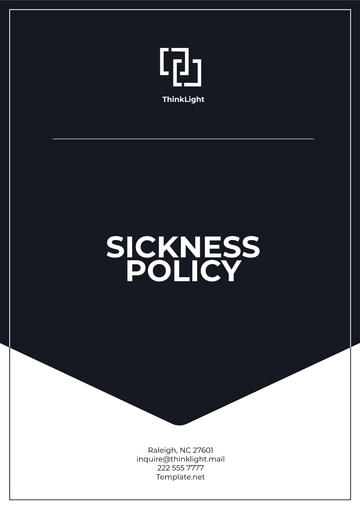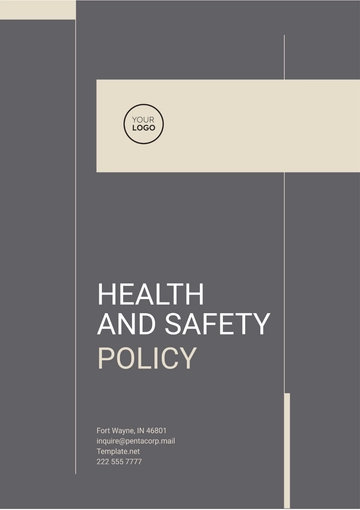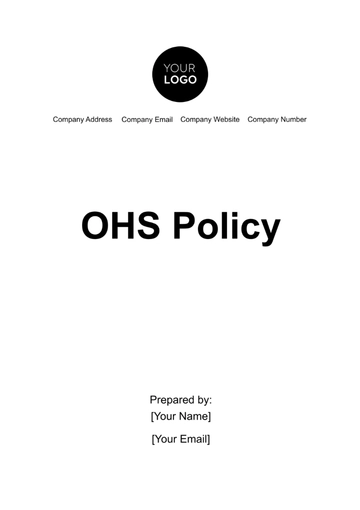Free Cleaning Services Hygiene Policy

I. Introduction
[Your Company Name] is committed to maintaining the highest standards of hygiene and cleanliness across all our operations. This policy outlines the rigorous procedures and practices we have implemented to ensure the health and safety of our employees, clients, and the environments we service.
Mandatory compliance with this policy by all employees ensures our services not only align with but also surpass regulatory mandates and industry best practices. This commitment is pivotal in fostering trust and reliability among our clientele and within our team.
II. Personal Hygiene
The foundation of our hygiene policy is based on the personal hygiene of our staff. It is crucial for maintaining a safe and healthy working environment, preventing the spread of germs and infections.
A. Hand Hygiene
Ensuring the cleanliness of hands is fundamental to personal hygiene and overall health safety.
Hand Washing Protocol: Employees are mandated to wash their hands with soap and water for a minimum of [20 seconds]. This practice is required at the beginning and end of shifts, prior to and subsequent to meal breaks, following restroom use, and after handling waste or cleaning agents.
Hand Sanitizer Use: Hand sanitizer dispensers are strategically placed across all facilities. Employees are instructed to use sanitizer when soap and water are not immediately accessible.
B. Personal Protective Equipment (PPE)
The use of PPE is critical in minimizing exposure to harmful substances and in preventing cross-contamination during cleaning processes.
Required PPE: All employees are obligated to wear appropriate personal protective equipment, which includes gloves, masks, and protective eyewear, throughout the execution of cleaning tasks.
PPE Management: It is imperative that PPE be appropriately changed and disposed of when transitioning between different cleaning zones to avert the risk of cross-contamination.
III. Cleaning and Disinfection Procedures
This segment summarizes the comprehensive standards and methodologies adopted for the thorough cleaning and disinfecting of client premises, thereby underpinning our unwavering commitment to public health and safety.
A. Routine Cleaning
Consistent and thorough cleaning forms the backbone of our hygiene maintenance strategy.
Pre-Disinfection Cleaning: Initially, all surfaces are subjected to a thorough cleaning using detergents endorsed by health authorities. This step is crucial for removing dirt and impurities that can inhibit the efficacy of disinfectants.
Focus on High-Touch Areas: Surfaces frequently contacted by hands, such as doorknobs, light switches, and countertops, are prioritized for cleaning a minimum of twice daily to minimize risk of pathogen transmission.
B. Disinfection Protocols
Following cleaning, disinfection procedures are rigorously applied to eliminate pathogens effectively.
Selection of Disinfectants: Only disinfectants approved by the Environmental Protection Agency (EPA) and proven effective against specified pathogens are utilized in our operations.
Application and Safety Procedures: Adherence to the manufacturer's guidance on application methods and ensuring proper ventilation during disinfection are mandatory to ensure safety and effectiveness.
IV. Waste Management
Integral to our hygiene and sanitation efforts is a robust waste management system designed to mitigate infection risks and uphold environmental cleanliness. This section delineates the protocol for the adept handling, storage, and disposal of waste, reinforcing our dedication to environmental stewardship and public health.
A. Handling and Storage
Effective segregation and storage practices are critical for efficient waste management.
Segregation by Waste Type: Waste is meticulously segregated into categories (e.g., general, recyclable, hazardous) and stored in designated containers to facilitate efficient disposal and recycling processes.
Container Management: Clearly labeled containers are strategically placed, ensuring they are accessible yet situated away from high-traffic zones to prevent accidental spillage or contamination.
B. Disposal
Timely and compliant disposal practices are essential for maintaining a clean and safe environment.
Disposal Schedule: Waste collection and disposal schedules are rigorously maintained to prevent the accumulation of waste, which could attract pests or become a source of contamination.
Handling Hazardous Waste: The disposal of hazardous waste is conducted in strict accordance with local environmental regulations and health guidelines to ensure public safety and environmental protection.
C. Waste Management Compliance Table
Waste Type | Segregation Container | Labeling | Placement | Disposal Schedule |
|---|---|---|---|---|
General Waste | Black Bags | ✓ | Low-Traffic Areas | Daily |
Recyclable Waste | Blue Bins | ✓ | Designated Areas | Weekly |
Hazardous Waste | Red Bins | ✓ | Secure Areas | As Required |
The table provides an overview of the waste management practices at [Your Company Name], highlighting the segregation, handling, and disposal procedures for different types of waste. Adhering to these protocols ensures the safety and cleanliness of the environments we service, reflecting our dedication to excellence in hygiene and environmental stewardship.
V. Training and Compliance
At [Your Company Name], we recognize the pivotal role that continuous training and stringent compliance monitoring play in upholding our hygiene standards. This commitment ensures that our team remains knowledgeable and adherent to the protocols that safeguard the health and safety of our employees, clients, and the communities we serve. This section details our structured approach to employee training and compliance oversight, foundational elements in our pursuit of excellence.
A. Employee Training
Employee training is essential for fostering a culture of hygiene and safety, ensuring that all team members are equipped with the knowledge and skills necessary to perform their duties effectively.
Orientation Training: New hires undergo an extensive orientation program, which includes comprehensive training on hygiene and safety protocols integral to [Your Company Name]'s operations.
Continuing Education: To maintain the highest standards of hygiene, all employees are required to participate in regular refresher courses. These sessions are designed to keep the team abreast of the latest practices, regulations, and technologies in hygiene management.
B. Compliance Monitoring
Compliance monitoring is critical for verifying the effective implementation of our hygiene policies and identifying areas for improvement.
Audits and Inspections: Through routine audits and inspections, we meticulously assess adherence to our hygiene protocols, ensuring that every aspect of our operations aligns with established standards.
Corrective Measures: In instances of non-compliance, immediate action is taken to rectify the issue. This includes the development and implementation of corrective action plans to prevent recurrence.
C. Training and Compliance Overview Table
Component | Frequency | Compliance Mechanism |
|---|---|---|
Orientation Training | At Hiring | Completion Certification |
Refresher Courses | Annually | Attendance and Test Scores |
Audits and Inspections | Quarterly | Audit Reports |
Corrective Action Plans | As Needed | Plan Implementation Tracking |
The table encapsulates [Your Company Name]'s structured approach to training and compliance, underscoring our dedication to maintaining the highest standards of hygiene and safety. This dual focus not only enhances our service quality but also reinforces our commitment to the well-being of our stakeholders and the environment.
VI. Environmental Sustainability and Hygiene
[Your Company Name] is deeply committed to environmental stewardship, recognizing that sustainable practices are inherently linked to effective hygiene management. This section outlines our approach to integrating environmental sustainability within our hygiene protocols, ensuring that our operations contribute positively to the health of the planet while maintaining our high standards of cleanliness and safety.
A. Sustainable Cleaning Products and Practices
Adopting eco-friendly cleaning solutions and methodologies is crucial for minimizing our environmental impact without compromising on hygiene.
Eco-Friendly Products: We prioritize the use of cleaning products that are environmentally safe, biodegradable, and certified by reputable eco-labels. This approach ensures that our cleaning practices are not only effective but also sustainable.
Resource Conservation: Our cleaning procedures are designed to optimize water and energy use, reducing our overall environmental footprint. Techniques such as concentrated formulas and efficient equipment play a key role in this effort.
B. Waste Reduction and Recycling
Minimizing waste generation and maximizing recycling are core components of our commitment to environmental sustainability.
Waste Minimization: Strategies to reduce waste include using reusable cleaning cloths and mop heads, and minimizing the use of disposable products.
Recycling Programs: We actively participate in recycling programs, ensuring that recyclable materials are properly sorted and processed. This includes paper, plastics, and metals, as well as appropriate disposal of electronic waste.
C. Employee Engagement and Training
Engaging our team in sustainability efforts is essential for fostering a culture of environmental responsibility.
Sustainability Training: Employees receive training on sustainability practices related to hygiene, emphasizing the importance of environmental conservation in our operations.
Green Initiatives: We encourage employee participation in green initiatives, both within the company and in their communities, to promote a broader impact on environmental preservation.
D. Environmental Sustainability and Hygiene Overview Table
Aspect | Strategy | Outcome Measure |
|---|---|---|
Eco-Friendly Products | Use of biodegradable and certified cleaners. | Reduction in Chemical Footprint |
Resource Conservation | Efficient water and energy use in cleaning. | Decrease in Resource Use |
Waste Minimization | Reusable materials and reduction of disposables. | Waste Reduction Metrics |
Recycling Programs | Sorting and recycling of materials. | Increase in Recycling Rates |
Sustainability Training | Education on eco-friendly hygiene practices. | Employee Engagement Levels |
Green Initiatives | Support for environmental projects. | Community Impact |
This table captures the essence of [Your Company Name]'s commitment to environmental sustainability within our hygiene practices. By embracing these strategies, we not only ensure the cleanliness and safety of the spaces we service but also contribute to the health and preservation of our planet. Our sustainable practices are a testament to our responsibility towards future generations, highlighting our dedication to creating a cleaner, greener world.
VII. Conclusion
This hygiene policy is a living document subject to regular review and updates to adapt to new health guidelines and best practices. All employees of [Your Company Name] are expected to familiarize themselves with this policy and incorporate these standards into their daily work routines. Compliance with this policy is not only a matter of company regulation but also a commitment to our collective health and safety.
- 100% Customizable, free editor
- Access 1 Million+ Templates, photo’s & graphics
- Download or share as a template
- Click and replace photos, graphics, text, backgrounds
- Resize, crop, AI write & more
- Access advanced editor
Ensure your business's hygiene standards are impeccable with the Cleaning Services Hygiene Policy Template from Template.net. This professionally designed template is both editable and customizable, allowing for seamless integration into your operational framework. Editable in our advanced Ai Editor Tool, this template empowers you to maintain and enhance your hygiene protocols efficiently.
You may also like
- HR Policy
- Restaurant Policy
- Company Policy
- Accounting Policies and Procedures
- Website Policy
- Privacy Policy
- Safety Policy
- School Policy
- IT and Software Policy
- Law Firm Policy
- Construction Policy
- Interior Design Policy
- Travel Agency Policy
- Education Academic Policy
- Security Policy
- Real Estate Policy
- Expense Policy
- Software Policy





























